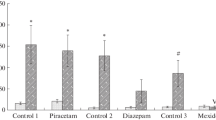Summary
A series of experiments was designed to compare the conditioned behavior of a subspecies of deermouse (Peromyscus maniculatus gracilis) in two response situations: 1. avoidance of shock by climbing a pole, and 2. avoidance of shock by remaining on a non-electrified pan located at grid level. This subspecies is semi-arboreal in its natural habitat. As was expected, an experimentally-induced response analogous to those to which the animal is phenotypically predisposed is rapidly acquired and resistant to spontaneous extinction. Thus, the pole response was acquired more rapidly, was more resistant to extinction, and was less susceptible to suppression by drugs. The stability of such behavior makes mice exhibiting this type of response advantageous for testing the effects of psychotropic drugs. The fact that chlorpromazine may be differentiated from pentobarbital by means of these technics supports this conclusion.
Similar content being viewed by others
References
Ader, R., and D. W. Clink: Effects of chlorpromazine on the acquisition and extinction of an avoidance response in the rat. J. Pharmacol. exp. Ther. 121, 144–148 (1957).
Cook, L., and E. Weidley: Behavioral effects of some psychopharmacological agents. Ann. N.Y. Acad. Sci. 66, 740–752 (1957).
Denenberg, V. H., S. Ross, and J. Ellsworth: Effects of chlorpromazine on acquisition and extinction of a conditioned response in mice. Psychopharmacologia (Berl.) 1, 59–64 (1959).
Hilgard, E. R., and D. G. Marquis: Conditioning and learning, 2nd ed. New York: Appleton-Century-Crofts 1961.
Horner, B. E.: Arboreal adaptations of Peromyscus, with special reference to use of the tail. Contr. Lab. Vert. Biol., Univ. of Mich. 61, 1–85 (1954).
King, J. A.: Maternal behavior and behavioral development in two subspecies of Peromyscus maniculatus. J. Mammal. 39, 177–190 (1958).
—, and N. J. Shea: Behavioral development in two subspecies of Peromyscus maniculatus. Anat. Rec. 181, 571–572 (1958).
— —: Subspecific differences in the responses of young deermice on an elevated maze. J. Hered. 50, 14–18 (1959).
Litchfield jr. J. T., and F. Wilcoxon: A simplified method of evaluating doseeffect experiments. J. Pharmacol. exp. Ther. 96, 99–113 (1949).
Maffii, G.: The secondary conditioned response of rats and the effects of some psychopharmacological agents. J. Pharm. Pharmacol. 11, 129–139 (1959).
Miller, R. E., J. V. Murphy, and I. A. Mirsky: The effect of chlorpromazine on fear-motivated behavior in rats. J. Pharmacol. exp. Ther. 120, 379–387 (1957).
Osgood, C. E.: Method and theory in experimental psychology. New York: Oxford University Press 1953.
Siegal, S.: Nonparametric statistics for the behavioral sciences. New York: McGraw-Hill 1956.
Verhave, T., J. E. Owen jr. and E. B. Robbins: Effects of chlorpromazine and secobarbital on avoidance and escape behavior. Arch. int. Pharmacodyn. 116, 45–53 (1958).
Woodworth, R. S., and H. Schlosberg: Experimental psychology, Revised ed. New York: Holt & Co. 1954.
Author information
Authors and Affiliations
Additional information
Supported by a research grant from the National Institute of Neurological Diseases and Blindness (B-381), National Institutes of Health, U.S. Public Health Service.
Portion of a thesis presented by Harold H. Wolf in partial fulfillment of the requirements for the degree of Doctor of Philosophy at the University of Utah.
Predoctoral Fellow 1960–61, National Institute of Mental Health, U.S. Public Health Service.
Rights and permissions
About this article
Cite this article
Wolf, H.H., Swinyabd, E.A. & Clark, L.D. The differential effects of chlorpromazine and pentobarbital on two forms of conditioned avoidance behavior in peromyscus maniculatus gracilis. Psychopharmacologia 3, 438–448 (1962). https://doi.org/10.1007/BF00411161
Received:
Issue Date:
DOI: https://doi.org/10.1007/BF00411161



